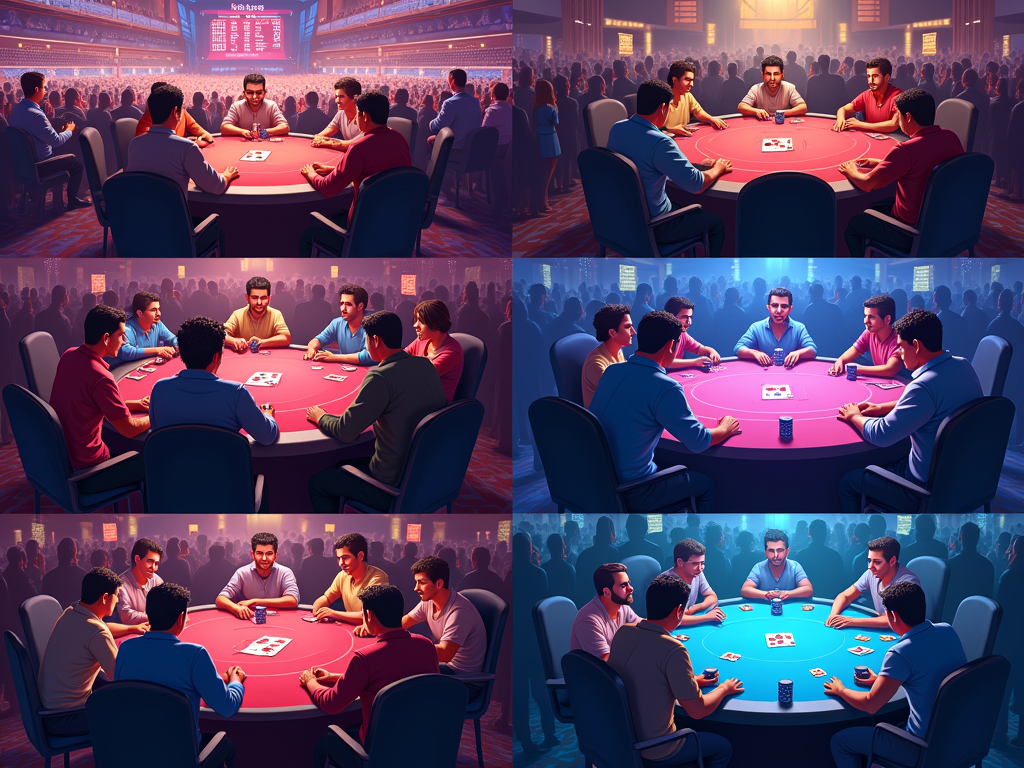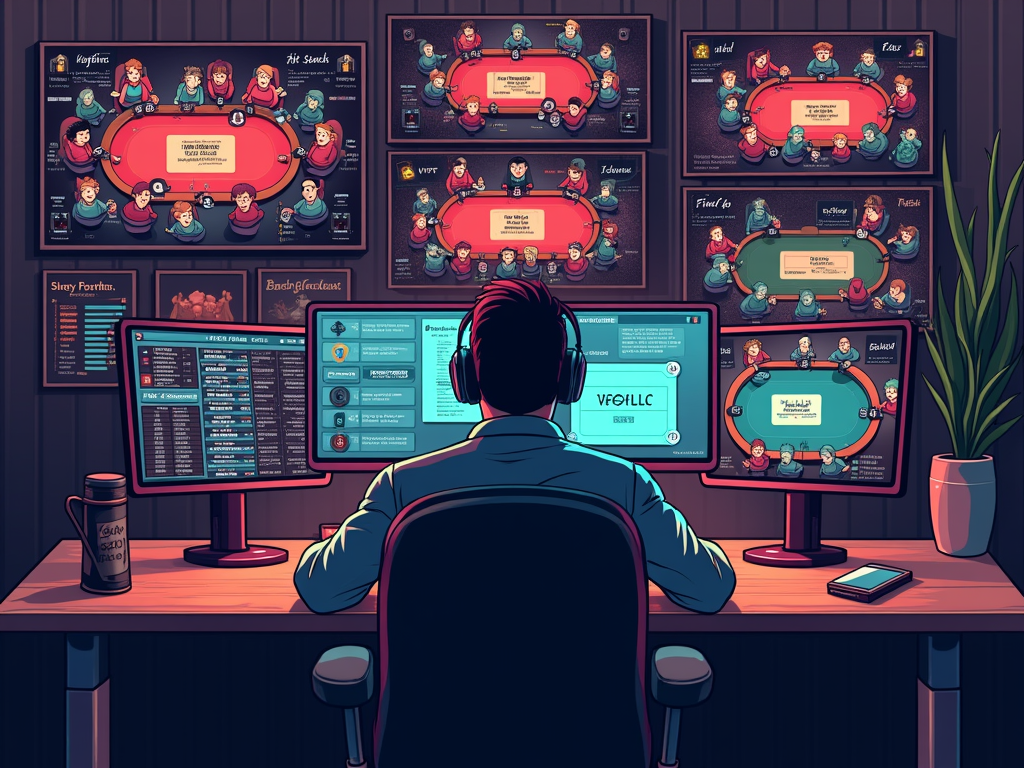Mastering Online Poker Tournaments
Online poker tournaments demand strategic mastery, emotional control, and disciplined bankroll practices. Each format brings unique challenges, from large-field MTTs (Multi-Table Tournaments) to fast-paced SNGs (Sit and Gos), with success hinging on adaptable strategies and smart resource management.
Key Takeaways
- Maintain a bankroll of 100–300 buy-ins for MTTs and 30–50 buy-ins for SNGs to manage variance effectively
- Adapt your strategy through tournament stages, from tight-aggressive early play to more aggressive late-stage tactics
- Use poker tracking software and analysis tools to identify leaks and improve decision-making
- Select tournaments based on bankroll size, skill level, and time commitment
- Practice consistent mental game management through regular breaks and emotional control techniques
Effective Bankroll Management
I emphasize solid bankroll management as the foundation for sustainable tournament success. My experience shows that strict adherence to buy-in limits prevents costly downswings and supports long-term profitability.
Adapting Strategy by Tournament Stage
Tournament strategy shifts dramatically from early to late stages. Early phases require patient, selective play while preserving chips. Middle stages demand increased aggression to build stacks. Late stages need aggressive exploitation of bubble dynamics and ICM (Independent Chip Model) considerations.
Using Software to Improve Performance
Modern poker software tools give critical insights into gameplay patterns. Hand tracking programs reveal statistical tendencies, while ICM calculators optimize crucial late-stage decisions. These analytical resources enhance strategic development and help identify areas for improvement.
Choosing the Right Tournaments
Tournament selection remains vital for success. I match games to my current skill level and bankroll size, avoiding overleveraged situations. Time management also factors into selection — SNGs suit shorter sessions while MTTs need extended focus periods.
Mastering the Mental Game
Mental game development deserves equal attention to technical skills. Regular breaks prevent fatigue and tilt. I practice mindfulness techniques between sessions to maintain emotional stability during crucial moments.
Understanding Poker Tournament Structure and Formats
Tournament poker comes in different shapes and sizes, each with unique characteristics that can impact your strategy and potential profits. I’ve found that mastering both Multi-Table Tournaments (MTTs) and Sit & Go’s (SNGs) creates the best foundation for becoming a successful poker player.
Key Tournament Types and Their Features
MTTs are the giants of tournament poker, featuring massive fields that can range from hundreds to more than 10,000 players. These tournaments typically pay out the top 10-15% of the field, creating substantial prize pools but requiring significant time investment and patience.
SNGs offer a more compact tournament experience. These single-table events usually seat 6-9 players and follow a fixed payout structure—commonly 50% to first place, 30% to second, and 20% to third. Their shorter duration makes them perfect for players with limited time or those looking to build experience quickly.
Blind structures play a crucial role in determining your tournament strategy. Here are the main formats you’ll encounter:
- Standard Structure: Features 10-15 minute blind levels, giving you plenty of time to make strategic decisions
- Turbo Format: Runs with 5-minute levels, requiring faster decision-making
- Hyper-Turbo Format: Uses 2-3 minute levels, demanding quick instincts and aggressive play
The bubble phase deserves special attention—it’s that nail-biting period just before players start getting paid. During this time, many participants tighten up significantly to secure a minimum cash, creating opportunities for more aggressive players to accumulate chips.
I’ve learned that success in these various formats depends on adjusting your strategy based on the structure. In MTTs, patience and careful stack preservation early on can pay off during the later stages. Meanwhile, SNGs require a more aggressive approach from the start due to their shorter duration and steeper blind increases.
Your choice between these formats should factor in your available time, skill level, and risk tolerance. MTTs offer larger potential payouts but demand more time and patience, while SNGs provide quicker results with more predictable time commitments.
Remember that blind structures dictate your playing style. Standard structures let you play a more technical game, while faster formats force you to make quick decisions and focus on fundamental strategies. Adapting to these different paces is essential for consistent tournament success.

The Smart Player’s Guide to Bankroll Management
I’ve learned that a solid bankroll management strategy stands as your strongest defense against the inevitable ups and downs of online poker tournament play. Your bankroll isn’t just money in your account – it’s your business capital and needs careful handling.
Essential Bankroll Requirements
Different tournament formats demand different bankroll sizes. Multi-table tournament (MTT) players need substantial cushioning. I recommend maintaining at least 100 buy-ins in your bankroll. For added security, keep 200-300 buy-ins if you’re taking a more careful approach. Sit-and-Go (SNG) players can operate with a smaller reserve, aiming for 30-50 buy-ins due to lower variance in these formats.
Here’s what smart bankroll management looks like in practice:
- Never risk more than 1–2% of your total bankroll in a single tournament
- Track your buy-ins and adjust stakes based on your current bankroll size
- Move down in stakes if your bankroll drops below recommended levels
- Set aside a portion of profits for bankroll growth
- Keep separate funds for living expenses and poker playing
MTTs show higher variance than SNGs because of their larger fields and prize structures. This means you’ll face longer stretches without cashing, making proper bankroll management even more critical. For example, if you’re playing $10 MTTs, you should have $1,000–$3,000 set aside specifically for poker.
During downswings—which will happen to every player—your bankroll strategy becomes your lifeline. I’ve found that calculating specific requirements helps ensure you’re competing at appropriate stakes. For instance, if your bankroll is $500, you should limit yourself to $5 SNGs or $2–$3 MTTs maximum.
This disciplined approach might feel restrictive at first, but it’s the foundation of long-term success in tournament poker. By protecting your bankroll, you’re protecting your ability to keep playing and improving at the tables.
Essential Tournament Strategies from Early to Late Stages
Mastering online poker tournaments requires adapting your strategy as the event unfolds. Each stage presents unique challenges and opportunities that demand different approaches to stay ahead of the competition. I’ve found that success comes from recognizing these distinct phases and adjusting your gameplay accordingly.
Early Stage Tactics
With deep stacks of 100-200 big blinds, the early stage is perfect for building your chip stack through calculated play. I recommend focusing on premium hands and extracting maximum value when you hit strong holdings. Here are the key strategies I’ve found most effective:
- Play tight-aggressive poker with an emphasis on value betting strong hands
- Avoid unnecessary confrontations without premium holdings
- Focus on pot control and building chips gradually
- Take advantage of loose players who overplay marginal hands
Middle Stage Adjustments
As the tournament progresses to the middle stages, you’ll notice stack sizes typically dropping to 30-50 big blinds. This is when I shift to a more aggressive style of play. Your focus should expand to include:
- Active blind stealing, especially from late position
- 3-bet bluffing against known aggressive players
- Defending your big blind more frequently
- Using position to pressure medium-stacked opponents
Late Stage Strategy
The late stages bring significant pressure as the money bubble approaches. With ICM considerations becoming crucial for tournament success, I pay extra attention to stack sizes and adjust my strategy accordingly:
- Implement push/fold strategy with 10-20 big blind stacks
- Target medium stacks who are playing too cautiously
- Avoid confrontations with larger stacks unless holding premium hands
- Apply pressure on the bubble, especially against short stacks
Heads-Up Play
During heads-up play, aggression becomes paramount. I’ve learned that position is incredibly powerful in these situations, and you should:
- Raise frequently when on the button
- Apply constant pressure to your opponent
- Adjust sizing based on stack depths
- Mix up your play to stay unpredictable
Final Table Considerations
Throughout the tournament, your success hinges on maintaining awareness of the changing dynamics at your table. I constantly monitor stack sizes, identify player tendencies, and adjust my strategy based on these factors. This flexible approach, combined with solid fundamental play, creates the foundation for consistent tournament success.
When you’re at the final table, precision in decision-making becomes even more critical. Short-stacked players must carefully choose their spots to shove, while bigger stacks should apply pressure without risking elimination unnecessarily. The key is finding the right balance between aggression and caution while accounting for pay jump considerations.
Remember that relative stack size dictates much of your strategy. If you’re the chip leader, use your stack to apply pressure. If you’re short, look for spots to double up through stronger players who have more to lose. Understanding these dynamics and adjusting your play accordingly will significantly improve your tournament results.

Maximizing Your Edge with Poker Software
Modern poker tournaments demand more than just intuition and experience. I’ve found that poker software tools give players a significant competitive advantage through data-driven decision making and strategic analysis.
Essential Tracking and Analysis Tools
Tracking software forms the backbone of serious tournament preparation. PokerTracker 4 and Hold’em Manager 3 stand out as the leading platforms for recording and analyzing hand histories. These programs create detailed performance reports and help identify leaks in your game.
Here are the key metrics these tools track and their typical ranges for successful players:
- VPIP (Voluntarily Put Money in Pot): Winning players often maintain around 15% for a tight-aggressive style
- PFR (Pre-Flop Raise): Strong players typically show around 12%
- 3-Bet Percentage: Look to maintain 5-7% in most tournament situations
- Aggression Factor: Aim for 2.0 or higher in most spots
Advanced Decision Support Software
I rely on specialized tools for specific aspects of tournament play. ICM calculators like ICMIZER prove invaluable during crucial late-stage decisions where prize pool distribution affects optimal strategy. These tools help calculate the real money value of each decision, preventing costly mistakes when payouts matter most.
For hand analysis, equity calculators like Equilab offer quick insights into matchup probabilities and range advantages. When I need deeper strategic understanding, GTO solvers like PioSOLVER reveal optimal play patterns that would be impossible to calculate manually.
The real skill lies in knowing when to use each tool. While some software assists with post-session review, others can support real-time decisions. I recommend focusing on:
- Using tracking software to analyze your play after sessions
- Running key hands through equity calculators during study time
- Applying ICM calculations in tournament preparation
- Incorporating solver insights into your overall strategy
Remember, these tools enhance rather than replace solid poker fundamentals. As you master the fundamentals of poker strategy, software can help refine your decision-making process and keep you ahead of the competition.
Always check the terms and conditions of your chosen poker site regarding authorized software use. Some platforms restrict certain tools, particularly those offering real-time assistance.

Tournament Selection and Preparation Essentials
Picking the right poker tournaments isn’t just about jumping into any game – it’s about making smart choices that match your skills and resources. I’ve learned that success in online poker tournaments requires careful planning and proper preparation.
Smart Tournament Selection Strategy
Bankroll management sits at the core of tournament selection. I recommend limiting buy-ins to no more than 5% of your total bankroll to protect yourself from excessive downswings. The tournament format also plays a crucial role in your success.
Here are the key factors I consider when selecting tournaments:
- Field size – Larger fields mean bigger prizes but lower chances of cashing
- Duration – Multi-table tournaments (MTTs) typically run 8-12 hours while Sit & Go’s (SNGs) finish within an hour
- Buy-in level – Should align with your current bankroll and skill level
- Starting stack size – Deeper stacks allow for more strategic play
- Prize structure – Top-heavy vs. flatter payouts affect strategy and variance
Getting ready for tournament play demands dedicated study time. Training platforms like Upswing Poker, Run It Once, and PokerCoaching.com offer structured learning paths with proven strategies. I make it a habit to review my hand histories regularly, focusing on critical decision points and identifying areas for improvement.
Setting up an optimal playing environment is essential for maintaining focus during long sessions. I ensure my setup includes:
- A comfortable chair and ergonomic workspace
- Multiple monitors for multi-tabling efficiency
- Reliable internet connection
- Quick access to tournament scheduling tools
- Note-taking capabilities for tracking player tendencies
Success in poker tournaments comes from combining proper game selection with thorough preparation. By choosing appropriate events and maintaining a disciplined approach to improvement, I’ve found that consistent results become much more achievable.

Managing Your Mental Game for Long-term Success
Building Your Mental Stamina
Mental game management can make or break your poker tournament success. I’ve found that starting with a single table allows you to build confidence while developing your emotional control. As your skills improve, you can steadily expand to playing multiple tables — but don’t rush this progression. Think of it like training for a marathon — you wouldn’t start by running the full distance on day one.
Taking regular 5–10 minute breaks every hour keeps your mind sharp during long sessions. I recommend using these breaks to stretch, hydrate, and reset mentally. This practice helps prevent mental fatigue that often leads to costly mistakes, especially when playing poker tournaments that stretch for several hours.
Emotional Control Strategies
Here are key techniques I use to maintain emotional balance during tournaments:
- Create a pre-game routine to ensure you’re mentally prepared
- Set clear stop-loss limits before starting play
- Practice deep breathing exercises during tough decisions
- Keep a tournament journal to track emotional patterns
- Step away from the tables when feeling tilted
- Focus on making correct decisions rather than results
Mental preparation before each session is crucial. I make sure I’m well-rested and free from distractions before sitting down to play. This means getting adequate sleep, eating properly, and having a clear mind focused solely on poker.
During inevitable downswings, maintaining emotional control becomes your most valuable skill. Instead of letting frustration drive your decisions, use these moments to refine your strategy and stay committed to playing your best game. Remember that variance is a natural part of poker — even the best players experience losing streaks.
For multi-table tournaments, I recommend using a systematic approach to manage your attention. This includes organizing your table layout efficiently, using time-bank features wisely, and maintaining a consistent decision-making process across all tables. By creating these structured habits, you’ll find it easier to stay focused and make better decisions even under pressure.
Sources:
Upswing Poker (Strategy Content, Blog Posts)
PokerCoaching.com (Strategy Content, Webinars)
Run It Once (Training Videos, Strategy Forums)
PokerNews (Tournament Reporting, Strategy Articles)
CardPlayer Magazine (Strategy Articles, Poker News)
Harrington on Hold’em Vol I & II (Tournament Strategy) by Dan Harrington
The Mental Game of Poker (Psychology) by Jared Tendler





